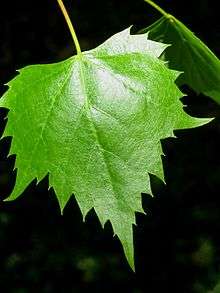Tilia mongolica
Tilia mongolica Maxim., commonly known as Mongolian lime, was discovered by Pere David in 1864, and introduced to the West by Bretschneider, who sent seed to Paris in 1880, and later the Arnold Arboretum in 1882.[1][2] The tree is native to Mongolia, eastern Russia, and northern China, growing at elevations of 1200–2200 m.[3]
| Tilia mongolica | |
|---|---|
 | |
| Mongolian lime leaf | |
| Scientific classification | |
| Kingdom: | Plantae |
| Clade: | Tracheophytes |
| Clade: | Angiosperms |
| Clade: | Eudicots |
| Clade: | Rosids |
| Order: | Malvales |
| Family: | Malvaceae |
| Genus: | Tilia |
| Species: | T. mongolica |
| Binomial name | |
| Tilia mongolica | |
Description
Mongolian lime is a small slow-growing deciduous tree of rounded, compact habit, reaching < 10 m in height. The dense, twiggy growth and glabrous reddish shoots bear leaves 4–7.5 cm long, coarsely toothed with 3–5 lobes, superficially resembling ivy or maple leaves. The emergent leaves are bronze, turning glossy green in summer, and bright yellow in autumn.[4] The greenish-white flowers are borne in clusters of 6–20 in June and July.[2]
 Mongolian Lime at Exbury, UK
Mongolian Lime at Exbury, UK Leaf and fruits of T. mongolica.
Leaf and fruits of T. mongolica.
Cultivation
A tree planted at Kew at the end of the 19th century flowered while only 1.5 m high in 1907. The tree was introduced to commerce in the UK by Harry Veitch at the Coombe Wood Nursery from material collected for him by Purdom in northern China.[1]
Notable trees
In the UK, the TROBI champion grows at Thorp Perrow Arboretum, Yorkshire; planted in 1936, it measured 20 m tall by 59 cm d.b.h. in 2004.[5] A specimen planted in 1983 grows at Exbury Gardens in Hampshire.
References
- Elwes, H. J. & Henry, A. (1913). The Trees of Great Britain & Ireland. Vol. 7, 1679–1680. Private publication, Edinburgh. Digitally reprinted by Cambridge University Press, 2014. ISBN 978-1-108-06938-0
- More, D. and White. J. (2003). Trees of Britain and Northern Europe, p.691. Cassell's, London. ISBN 0-304-36192-5
- Tang, Y., Gilbert, M. G., & Dorr, L. J. Tiliaceae, in Wu, Z. & Raven, P. (eds) (2007). Flora of China, Vol. 12. Science Press, Beijing, and Missouri Botanical Garden Press, St. Louis, USA.
- Hillier & Sons (1977). Hillier's Manual of Trees & Shrubs. 4th edition. David & Charles, Newton Abbot, UK.
- Johnson, O. (ed.). (2011). Champion Trees of Britain & Ireland. Royal Botanic Gardens, Kew, London. ISBN 978-1842464526